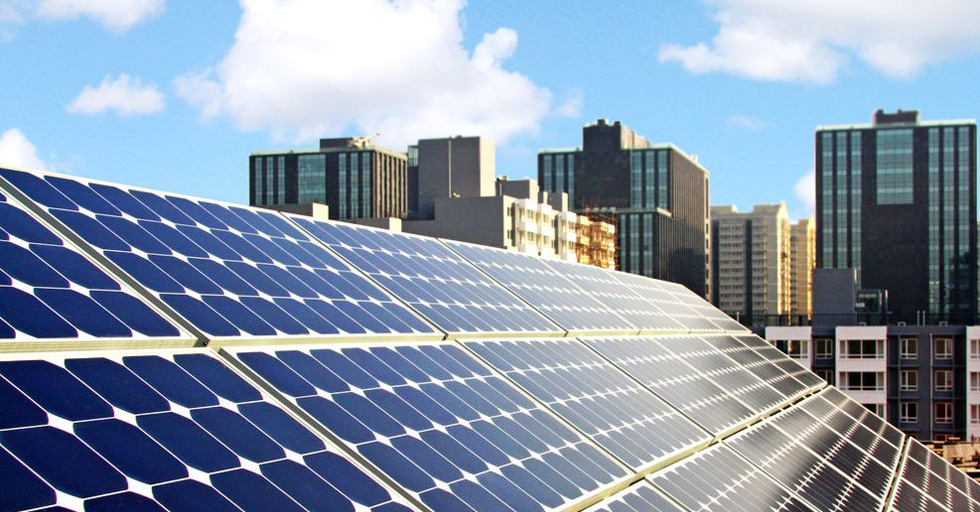In a report, ‘Accelerating India’s Clean Energy Transition,’ released at the BNEF Future of Energy Summit in Shanghai, China, researchers have found that the rooftop PV sector in India presents a $23 billion investment opportunity, based on its target of 40 GW of rooftop PV by 2022.
However, with a compound annual growth rate (CAGR) of 117% in annual installations between FY2013 and FY2017 – which makes it the fastest growing renewable energy sub-segment in India – BNEF estimates India will reach just 9.5GW of rooftop PV capacity by FY2022 – seven times its current total, but approximately 75% short of its national target. As such, its 40 GW targets is “unachievable”.
Falling costs
Overall, the report finds that the rooftop solar market will grow “with or without” the support of distribution utilities. This presents an opportunity for the DISCOMs to diversify and start their own rooftop solar business rather than lose customers to other competitors,” write the authors.
They go on to say the cost of electricity from rooftop PV has halved in the last five years, due to fierce competition in the market and a drop in equipment prices. In contrast, average retail electricity rates have increased by 22% in the same period. This has made rooftop PV cheaper than commercial and industrial (C&I) grid tariffs in all the major Indian states.
For commercial customers, payback periods are already averaging five to seven years. A drop-in equipment costs, and rising grid tariffs will further lower the payback periods for C&I consumers.
According to BNEF, rooftop PV is showing signs of a maturing market in the corporate segment. C&I customers now set-up larger capacity rooftop PV assets and are also open to signing long-term power purchase agreements (PPAs), indicating growing confidence in this technology. The economics of PV work for C&I customers even without net metering.
Underlining the common scenario, where residential consumers usually draw less power during the day when solar modules are producing the electricity, Itamar Orlandi, head of frontier markets at BNEF, said, “Net metering is a far more important enabler for residential small-scale solar than for business-scale projects.”
BNEF expects the residential rooftop solar sector to pick up rapidly post-2021. At the moment, its attractiveness for developers and customers is being held back by the high upfront capital expenditure that is necessary based on a shortage of financing options, and the fact grid electricity is cheaper for residential consumers with low consumption.
Back on November 08, Anirudh Ramesh from Soreva Energy, shared his insights with pv magazine regarding grid integration issues with residential rooftop PV.
Utilities can provide critical insights into customer load patterns and payment history, which can help RESCO (Renewable energy service company) developers with system sizing and off-taker credibility assessments. India is expected to install more renewable energy than fossil fuel power generation in 2017.
To promote the residential rooftop sector, the Indian government recently announced the ‘rent a roof’ policy, where solar developers will rent rooftop space, fit it with solar, and then offer the lease to households. Other stakeholders, like the Climate Policy Initiative (CPI), have also recommended financial solutions through Indo-U.S. initiatives to accelerate growth in India.
Lowest in the world
BNEF compared India’s rooftop market with other global markets. The LCOE [Levelized cost of electricity] of rooftop PV in India for both residential ($0.077/kWh) and commercial ($0.062/kWh) consumers is one of the lowest in the world, and comparable only to some of the sunniest parts in Australia and U.S.
The low price is driven by capital expenditures 39% to 50% lower than the global average. All components, including equipment, EPC, labor and soft costs are cheaper in India. The capital costs are even lower than China, where India imports most of its PV equipment.
This content is protected by copyright and may not be reused. If you want to cooperate with us and would like to reuse some of our content, please contact: editors@pv-magazine.com.








By submitting this form you agree to pv magazine using your data for the purposes of publishing your comment.
Your personal data will only be disclosed or otherwise transmitted to third parties for the purposes of spam filtering or if this is necessary for technical maintenance of the website. Any other transfer to third parties will not take place unless this is justified on the basis of applicable data protection regulations or if pv magazine is legally obliged to do so.
You may revoke this consent at any time with effect for the future, in which case your personal data will be deleted immediately. Otherwise, your data will be deleted if pv magazine has processed your request or the purpose of data storage is fulfilled.
Further information on data privacy can be found in our Data Protection Policy.